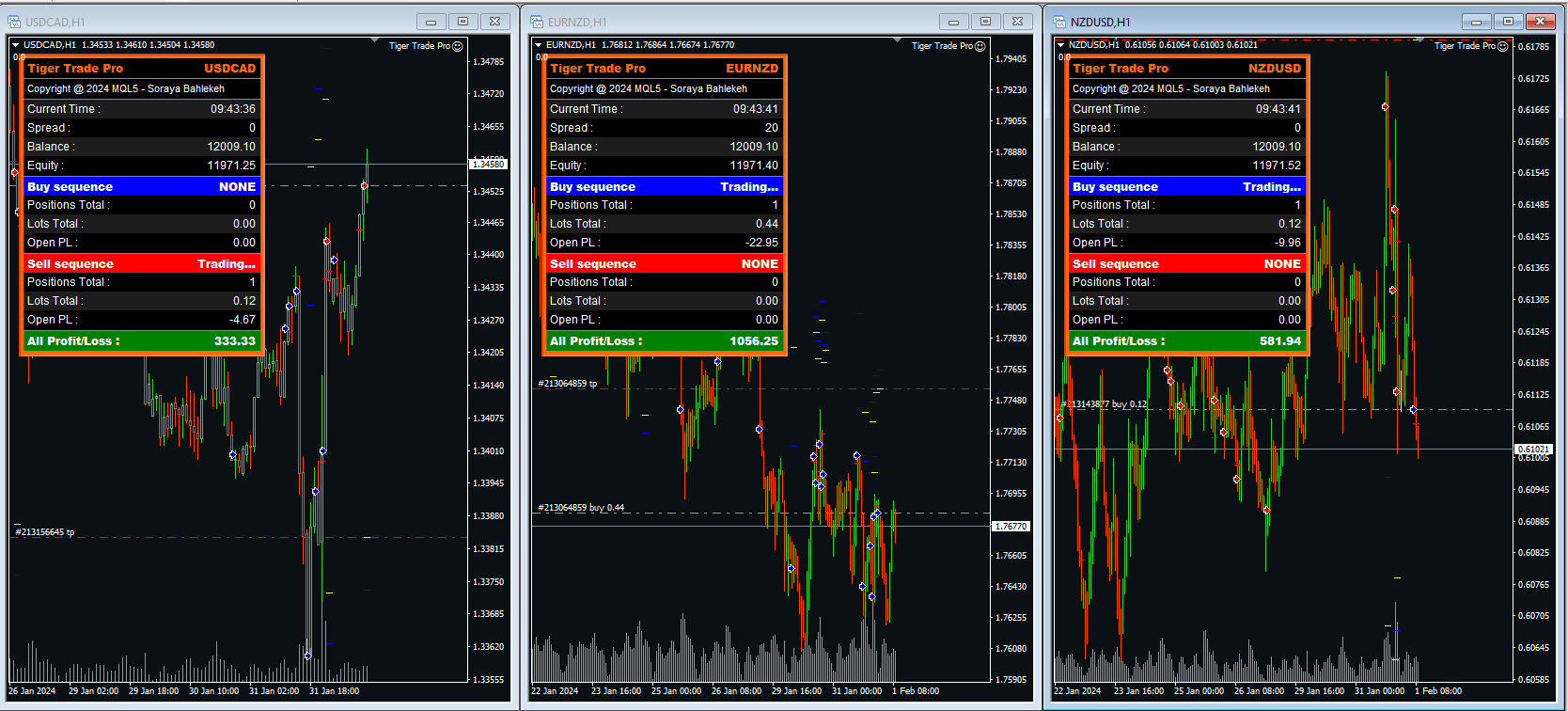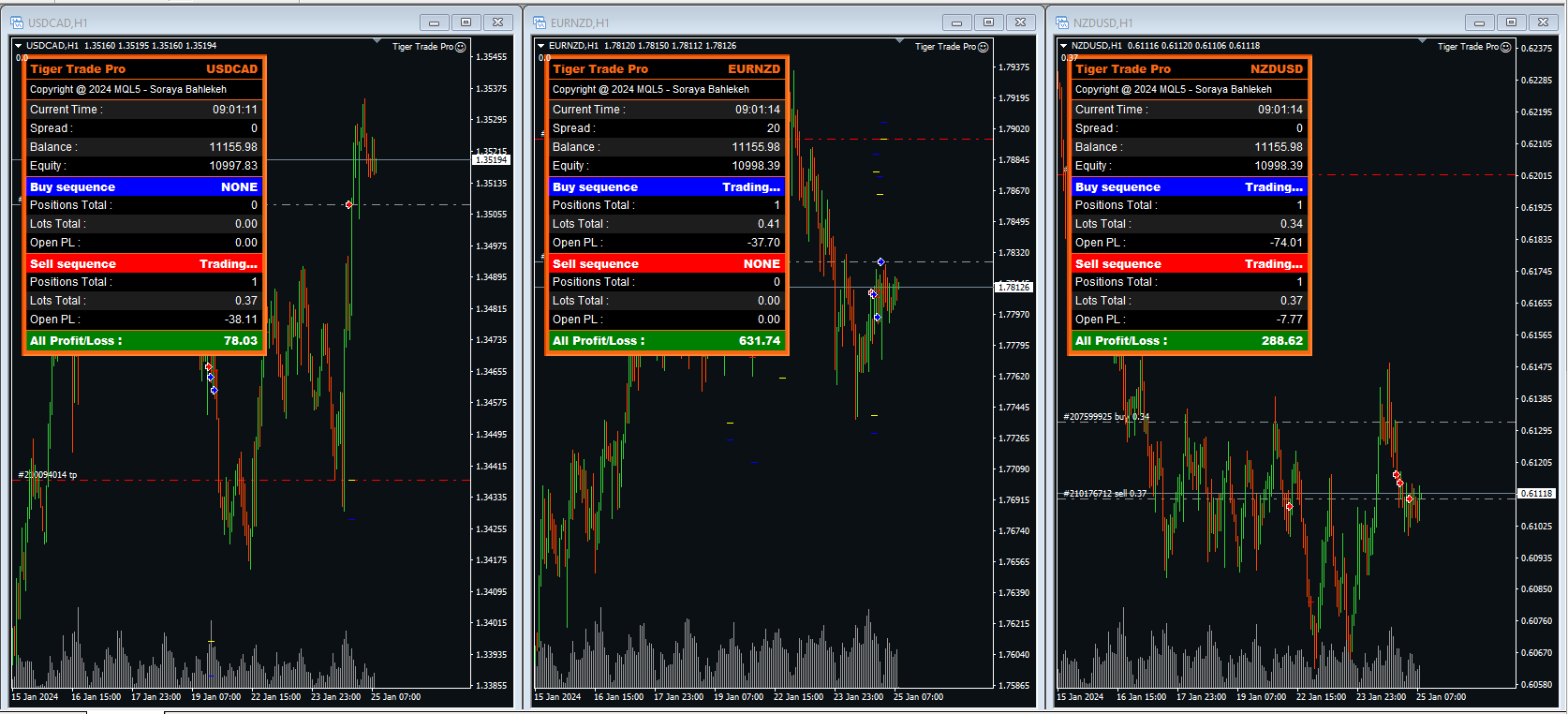Soraya Bahlekeh / Perfil
- Informações
|
1 ano
experiência
|
3
produtos
|
1286
versão demo
|
|
0
trabalhos
|
0
sinais
|
0
assinantes
|
If you require guidance and advice, please feel free to send me a private message, and I will respond as soon as possible.
Soraya Bahlekeh
Produto publicado
Prop Hunter Pro EA é um Consultor Especialista (EA) avançado com 6 estratégias meticulosamente elaboradas, incluindo HFT e Scalping . Três dessas estratégias são projetadas para ajudar os traders a superar os desafios impostos pelas empresas de prop trading, enquanto as outras três são destinadas para uso em contas de trading pessoais. Preço original 399$ —> 60% de desconto somente $169 (4 cópias disponíveis ) Para ver seu funcionamento ao vivo, você pode verificar fazendo
Soraya Bahlekeh

Performance of Tiger Trade Pro in the last 12 days.
profit : 20%
As you can see, it has performed best on the EURNZD currency pair.
Live Signals : https://bit.ly/tigertradepro
profit : 20%
As you can see, it has performed best on the EURNZD currency pair.
Live Signals : https://bit.ly/tigertradepro
Soraya Bahlekeh


In the last 7 days, there has been a 12% profit.
Tiger Trade Pro is designed to facilitate easy profit generation. You can keep the EA active 24 hours a day or set specific trading times according to your preferences
Tiger Trade Pro is designed to facilitate easy profit generation. You can keep the EA active 24 hours a day or set specific trading times according to your preferences
Kevin Maher
2024.01.26
Nice EA with impressive results vs. price. However, I only use the MT5 platform. Please make a MT5 version!
Soraya Bahlekeh
I am a passionate programmer who has been immersed in the exciting world of financial markets and programming for over a decade. From my early days as a student, I was captivated by the dynamic intersection of these two realms. Now, with more than 10 years of experience under my belt, I take great pride in being a seasoned specialist in the field of financial markets.
Throughout my journey, I have assembled a formidable team of experts who share my enthusiasm and drive. Together, we have delved into the realm of automated trading robots specifically tailored for the Forex market. These robots are the culmination of relentless effort, extensive research, and a fusion of cutting-edge technology with the intricacies of financial trading.
Today, I am thrilled to showcase our exceptional robots as a symbol of precision, power, and top-notch performance in the realm of financial markets. Our robots have been meticulously designed to excel in optimizing time efficiency while executing intelligent and profitable trades. By harnessing the power of advanced data analysis and intricate mathematical equations, our robots make informed decisions with unwavering accuracy.
We firmly believe that the marriage of specialized financial knowledge and programming expertise is the key to crafting autonomous robots that effortlessly navigate the complexities of the market. Our ultimate aim is to empower traders and investors with a powerful tool that enhances their trading capabilities, maximizes profitability, and ushers them into a new era of success in the financial landscape.
Join us on this thrilling journey as we continue to push the boundaries of innovation, refining our robots, and revolutionizing the way trading is conducted in the dynamic world of financial markets. Together, let us unlock the immense potential that lies at the intersection of technology and finance.
Throughout my journey, I have assembled a formidable team of experts who share my enthusiasm and drive. Together, we have delved into the realm of automated trading robots specifically tailored for the Forex market. These robots are the culmination of relentless effort, extensive research, and a fusion of cutting-edge technology with the intricacies of financial trading.
Today, I am thrilled to showcase our exceptional robots as a symbol of precision, power, and top-notch performance in the realm of financial markets. Our robots have been meticulously designed to excel in optimizing time efficiency while executing intelligent and profitable trades. By harnessing the power of advanced data analysis and intricate mathematical equations, our robots make informed decisions with unwavering accuracy.
We firmly believe that the marriage of specialized financial knowledge and programming expertise is the key to crafting autonomous robots that effortlessly navigate the complexities of the market. Our ultimate aim is to empower traders and investors with a powerful tool that enhances their trading capabilities, maximizes profitability, and ushers them into a new era of success in the financial landscape.
Join us on this thrilling journey as we continue to push the boundaries of innovation, refining our robots, and revolutionizing the way trading is conducted in the dynamic world of financial markets. Together, let us unlock the immense potential that lies at the intersection of technology and finance.
Soraya Bahlekeh
Using Technical Indicators in Forex Trading:
Technical indicators can help traders analyze price patterns and trends, identify entry and exit points, and make informed trading decisions. Let's discuss some popular technical indicators and how to use them effectively:
Moving Average:
Simple Moving Average (SMA): SMA calculates the average price over a specified period of time. Using SMA can help identify price trends and confirm entry and exit signals.
Exponential Moving Average (EMA): EMA is similar to SMA but gives more weight to recent prices. EMA, being a dynamic indicator, can reflect the speed of price changes.
Relative Strength Index (RSI):
RSI is a popular indicator that measures the strength and direction of a price trend. It ranges from 0 to 100, and when RSI approaches the upper range (above 70), the market may be overbought, and when it approaches the lower range (below 30), the market may be oversold.
Moving Average Convergence Divergence (MACD):
MACD is a lagging indicator used to identify changes in trend direction and potential continuation or reversal of price trends. Its main components include the MACD line, signal line, and histogram.
Bollinger Bands:
Bollinger Bands consist of a middle band (SMA or EMA), an upper band (standard deviation multiplied by a factor), and a lower band (standard deviation multiplied by a factor). They help identify periods of high or low volatility and potential price breakouts.
Fibonacci Retracement:
Fibonacci retracement is based on the Fibonacci sequence and is used to identify potential support and resistance levels. Traders use these levels to determine entry and exit points in a trending market.
Remember, technical indicators should not be used in isolation but as part of a comprehensive trading strategy. It's crucial to combine technical analysis with fundamental analysis, risk management techniques, and market understanding for successful trading.
Technical indicators can help traders analyze price patterns and trends, identify entry and exit points, and make informed trading decisions. Let's discuss some popular technical indicators and how to use them effectively:
Moving Average:
Simple Moving Average (SMA): SMA calculates the average price over a specified period of time. Using SMA can help identify price trends and confirm entry and exit signals.
Exponential Moving Average (EMA): EMA is similar to SMA but gives more weight to recent prices. EMA, being a dynamic indicator, can reflect the speed of price changes.
Relative Strength Index (RSI):
RSI is a popular indicator that measures the strength and direction of a price trend. It ranges from 0 to 100, and when RSI approaches the upper range (above 70), the market may be overbought, and when it approaches the lower range (below 30), the market may be oversold.
Moving Average Convergence Divergence (MACD):
MACD is a lagging indicator used to identify changes in trend direction and potential continuation or reversal of price trends. Its main components include the MACD line, signal line, and histogram.
Bollinger Bands:
Bollinger Bands consist of a middle band (SMA or EMA), an upper band (standard deviation multiplied by a factor), and a lower band (standard deviation multiplied by a factor). They help identify periods of high or low volatility and potential price breakouts.
Fibonacci Retracement:
Fibonacci retracement is based on the Fibonacci sequence and is used to identify potential support and resistance levels. Traders use these levels to determine entry and exit points in a trending market.
Remember, technical indicators should not be used in isolation but as part of a comprehensive trading strategy. It's crucial to combine technical analysis with fundamental analysis, risk management techniques, and market understanding for successful trading.
Soraya Bahlekeh
The hedging strategy is a method used to reduce risks in trading and financial investments. Essentially, hedging is employed to protect financial positions against price fluctuations, exchange rates, and other market factors. This approach is commonly used by companies, investors, and traders in financial markets.
One common method of hedging is through the use of futures contracts. By buying or selling futures contracts, individuals can lock in the price of a desired product or asset. This enables them to benefit from price increases or decreases in the future.
Another hedging method is engaging in offsetting transactions (e.g., trading in the spot market or in the options market). By executing offsetting trades, individuals can reduce risk while still taking advantage of profitable opportunities.
Implementing a hedging strategy requires careful market analysis, risk assessment, and precise portfolio management. Its main objective is to mitigate price volatility, preserve capital, and maintain profitability in turbulent market conditions.
One common method of hedging is through the use of futures contracts. By buying or selling futures contracts, individuals can lock in the price of a desired product or asset. This enables them to benefit from price increases or decreases in the future.
Another hedging method is engaging in offsetting transactions (e.g., trading in the spot market or in the options market). By executing offsetting trades, individuals can reduce risk while still taking advantage of profitable opportunities.
Implementing a hedging strategy requires careful market analysis, risk assessment, and precise portfolio management. Its main objective is to mitigate price volatility, preserve capital, and maintain profitability in turbulent market conditions.
:

